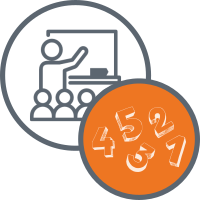You are here
Effective Mathematics Teaching Practice 8: Elicit and Use Evidence of Student Thinking
Instructional Support Menu
Elicit and Use Evidence of Student Thinking
One of the most important traits of successful teachers is that they are insatiably curious about what their students know and understand. This isn’t the kind of curiosity that leads teachers to wonder, “Can my students answer 80 percent of these questions correctly?” Rather, it’s the kind of curiosity that leads teachers to look at how students are thinking, how that thinking develops over time, and how the student responds to and overcomes obstacles along the way.
Looking for these deeper levels of understanding should not be left to chance. It is the teacher’s responsibility to strategically check in with students during critical moments while they work on high-quality tasks. to plan key questions in advance that focus students on the underlying mathematics and press them to explain their understanding, and to make sense of students’ mathematical representations. A teacher needs to make sense of all this and use that to support the progress students show in their mathematical understanding. Feedback should be focused on students’ understanding of a task and the underlying mathematical ideas, and not be aimed at students’ egos by simply indicating what students have done right or wrong.
Effective teaching of mathematics uses evidence of student thinking to assess progress toward mathematical understanding and to adjust instruction continually in ways that support and extend learning.
-NCTM (2014), p. 53
The Practice in Action
One of the ways NCTM (2014, p. 56) summarizes the practice of elicit and use evidence of student thinking is by describing a set of actions expected of teachers and students that indicate engagement in this teaching practice.
Caution! Don't over-estimate your own understanding based on these brief descriptions of teaching practice. Professional educators should dig more deeply into NCTM's resources, join study groups and professional networks, and seek out professional development and coaching to ensure high-quality engagement in the practice.
What are teachers doing?
- Identifying what counts as evidence of student progress toward mathematics learning goals.
- Eliciting and gathering evidence of student understanding at strategic points during instruction.
- Interpreting student thinking to assess mathematical understanding, reasoning, and methods.
- Making in-the-moment decisions on how to respond to students with questions and prompts that probe, scaffold, and extend.
- Reflecting on evidence of student learning to inform the planning of next instructional steps.
What are students doing?
- Revealing their mathematical understanding, reasoning, and methods in written work and classroom discourse.
- Reflecting on mistakes and misconceptions to improve their mathematical understanding.
- Asking questions, responding to, and giving suggestions to support the learning of their classmates.
- Assessing and monitoring their own progress toward mathematics learning goals and identifying areas in which they need to improve.
Resources
- Principles to Action: Ensuring Mathematical Success for All (2014, pp. 53-56)
- Taking Action: Implementing Effective Mathematics Teaching Practices in K-Grade 5, pp. 181-211
- Taking Action: Implementing Effective Mathematics Teaching Practices in Grades 6-8, pp. 143-167
- Taking Action: Implementing Effective Mathematics Teaching Practices in Grades 9-12, pp. 149-181
- Enhancing Classroom Practice with Research behind Principles to Actions, pp. 89-97




Connect With Us




